658
Year 658 (DCLVIII) was a common year starting on Monday (link will display the full calendar) of the Julian calendar. The denomination 658 for this year has been used since the early medieval period, when the Anno Domini calendar era became the prevalent method in Europe for naming years.
| Millennium: | 1st millennium |
|---|---|
| Centuries: | |
| Decades: | |
| Years: |
|
| 658 by topic |
|---|
| Leaders |
| Categories |
|
| Gregorian calendar | 658 DCLVIII |
| Ab urbe condita | 1411 |
| Armenian calendar | 107 ԹՎ ՃԷ |
| Assyrian calendar | 5408 |
| Balinese saka calendar | 579–580 |
| Bengali calendar | 65 |
| Berber calendar | 1608 |
| Buddhist calendar | 1202 |
| Burmese calendar | 20 |
| Byzantine calendar | 6166–6167 |
| Chinese calendar | 丁巳年 (Fire Snake) 3354 or 3294 — to — 戊午年 (Earth Horse) 3355 or 3295 |
| Coptic calendar | 374–375 |
| Discordian calendar | 1824 |
| Ethiopian calendar | 650–651 |
| Hebrew calendar | 4418–4419 |
| Hindu calendars | |
| - Vikram Samvat | 714–715 |
| - Shaka Samvat | 579–580 |
| - Kali Yuga | 3758–3759 |
| Holocene calendar | 10658 |
| Iranian calendar | 36–37 |
| Islamic calendar | 37–38 |
| Japanese calendar | N/A |
| Javanese calendar | 549–550 |
| Julian calendar | 658 DCLVIII |
| Korean calendar | 2991 |
| Minguo calendar | 1254 before ROC 民前1254年 |
| Nanakshahi calendar | −810 |
| Seleucid era | 969/970 AG |
| Thai solar calendar | 1200–1201 |
| Tibetan calendar | 阴火蛇年 (female Fire-Snake) 784 or 403 or −369 — to — 阳土马年 (male Earth-Horse) 785 or 404 or −368 |

Painting of Jajang (590–658)
Events
By place
Byzantine Empire
- Emperor Constans II undertakes an expedition to the Balkan Peninsula, and defeats the Avars in Macedonia. He temporarily reasserts Byzantine rule, and resettles some of them in Anatolia to fight against the Rashidun Caliphate (approximate date).
Europe
- The confederation of Slavic tribes falls apart after the death of King Samo. A Slav principality is formed from the kingdom's remnants in Carinthia (modern Austria), and the Avars capture most of its territory in Hungary (approximate date).
Britain
- Battle of Peonnum: King Cenwalh and the Wessex Saxons make a push against Dumnonia (South West England). They are victorious at Penselwood in Somerset, and the Dumnonia-Wessex border is set at the River Parrett (approximate date).
- A revolt led by three Mercian noblemen (Immin, Eata, and Eadberht) installs Wulfhere (son of king Penda) as ruler of Mercia, and drives out the supporters of King Oswiu of Northumbria.[1]
Asia
- The Chinese Buddhist monks Zhi Yu and Zhi You recreate several south-pointing chariots, for the Japanese prince Tenji. This is a 3rd-century device made by Ma Jun, and acts as a mechanical-driven directional-compass vehicle (according to the Nihon Shoki).
- Chinese forces defeat the Western Turkic Kaganate (Central Asia). The West kaganate becomes a vassal of the Tang Dynasty. During the power vacuum, Turgesh tribes emerge as the leading power (approximate date).
Births
- Willibrord, Anglo-Saxon missionary
Deaths
- Cellach mac Máele Coba, high king of Ireland
- Chu Suiliang, chancellor of the Tang Dynasty (b. 597)
- Clovis II, king of Neustria and Burgundy (or 657)
- Du Zhenglun, chancellor of the Tang Dynasty
- Erchinoald, mayor of the Palace of Neustria
- Jajang, Korean Buddhist monk (b. 590)
- Judicael, high king of Domnonée
- Samo, king of the Slavs (Carinthia)
- Yuchi Gong, general of the Tang Dynasty (b. 585)
gollark: I haven't seen any evidence that human behavior arises from anything more than, well, physics.
gollark: What does the "infinite" have to do with anything, also?
gollark: I would not mind patches for cognitive biases and stuff.
gollark: Well, you could fix some of the more egregious bugs in humans without losing anything important, surely.
gollark: ...
References
- Bede, "Ecclesiastical History", Book II, Chapter 24
This article is issued from Wikipedia. The text is licensed under Creative Commons - Attribution - Sharealike. Additional terms may apply for the media files.